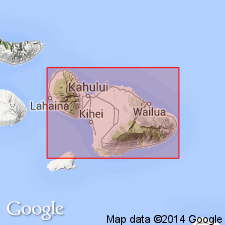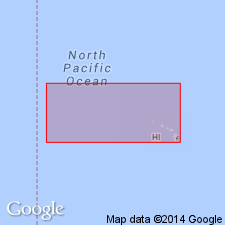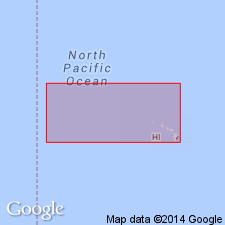
- Usage in publication:
-
- Kipahulu member*
- Modifications:
-
- Named
- Dominant lithology:
-
- Basalt
- AAPG geologic province:
-
- Maui
Summary:
Named for series of lava flows on W side of Kipahulu Valley E end of Island of Maui. Included as Kipahulu member of Hana volcanic series (new). Exposed over area 6 mi long and 0.5 to 1 mi wide. Lavas chiefly fine-grained aa in dense beds some of which are columnar jointed; also includes cinder cones and vitric ash. Total thickness may exceed 1500 ft in Kipahulu Valley. Overlies with erosional unconformity Honomanu and Kula volcanic series. Unconformably underlies Quaternary alluvium at mouth of valley. As part of Hana volcanic series assigned middle(?) and late Pleistocene and Recent age on map.
Source: GNU records (USGS DDS-6; Menlo GNULEX).

- Usage in publication:
-
- Kipahulu formation*
- Modifications:
-
- Revised
- AAPG geologic province:
-
- Maui
Summary:
Kipahulu member (Stearns and Macdonald, 1942) raised in rank to Kipahulu Formation, unit in Hana volcanic series. Type locality: Kipahulu Valley [20 deg 42' 03"N, 156 deg 05' 25"W, Kipahulu 7.5' quad] east end of Island of Maui. Correlative with other parts of Hana volcanic series. Assigned Pleistocene(?) age.
Source: GNU records (USGS DDS-6; Menlo GNULEX).

- Usage in publication:
-
- Kipahulu Member*
- Modifications:
-
- Revised
- AAPG geologic province:
-
- Maui
Summary:
Kipahulu Formation of Macdonald and Davis IN Avias (1956) now reduced to Kipahulu Member of Hana Volcanic Series on map. (p.321)
Source: GNU records (USGS DDS-6; Menlo GNULEX).

- Usage in publication:
-
- Kipahulu Member*
- Modifications:
-
- Overview
- AAPG geologic province:
-
- Maui
Summary:
Kipahulu Member (Macdonald and Abbott, 1970; Macdonald and others, 1983; Stearns, 1985) retained as member of Hana Volcanics because it is fairly extensive unit and is separated from earlier Hana flows by erosional unconformity Composed of late alkalic rejuvenated-stage lava of alkalic basalt and basanite; rare ankaramite and hawaiite. Is probably Pleistocene(?) age based on stratigraphic relations to older units of Hana Volcanics.
Source: GNU records (USGS DDS-6; Menlo GNULEX).
For more information, please contact Nancy Stamm, Geologic Names Committee Secretary.
Asterisk (*) indicates published by U.S. Geological Survey authors.
"No current usage" (†) implies that a name has been abandoned or has fallen into disuse. Former usage and, if known, replacement name given in parentheses ( ).
Slash (/) indicates name conflicts with nomenclatural guidelines (CSN, 1933; ACSN, 1961, 1970; NACSN, 1983, 2005, 2021). May be explained within brackets ([ ]).

